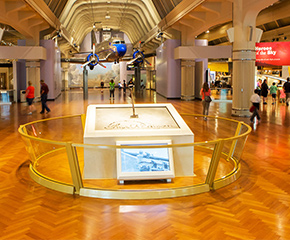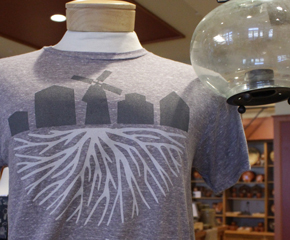
America’s Stories
Come to Life
Improving Henry Ford Museum
During the 1950s and the 1960s, the now-renamed Henry Ford Museum engaged a new generation of museum-goers. Galleries and period rooms along the front corridor contained groupings of furniture, ceramics, glassware, and silver to show the evolution of American taste. In the factory-like “Exhibit Hall” in back, transportation and other collections were arranged in rows. Changing exhibits offered new ways of looking at the collections.
As the museum moved toward its fiftieth anniversary in 1979, the vast Hall of Technology (now the William Clay Ford Hall of American Innovation) underwent a total redesign. Previous rows of cars, spinning wheels, tractors, and other objects were made more understandable through better organized displays with uniform labels.

Renewing Greenfield Village
At the same time, Greenfield Village became more active and welcoming. Many historic homes that previously had been used by Edison Institute School students were now opened to the public. Heinz House and Dr. Howard’s Office were added during this time. Demonstrations of early American crafts were revived. New special events were launched, beginning in 1951 with the Country Fair of Yesteryear and Old Car Festival.
The 1970s witnessed a flurry of planning and construction, with a steady stream of improvements in preparation for America’s Bicentennial in 1976 and the museum’s own 50th anniversary in 1979. Highlights included a new perimeter railroad, a re-created turn-of-the-century amusement park, and the historic 18th-century Connecticut saltbox house (now Daggett Farmhouse).
A major purpose of our development program is to add the means by which we can offer visitors a greater sense of personal participation—all within a historical context.William Clay Ford Chairman of the Board, Greenfield Villager, July 1972
Ongoing Transformation
Guided by the 1980s mission-based phrase, “Stories of a Changing America,” Greenfield Village took on new life and Henry Ford Museum exhibits explored new topics. These included the acquisition of the Firestone farmhouse and creation of its living history program (1985), the “Automobile in American Life” exhibit (1987), and the “Made in America” exhibit (1992). During the 1980s and 1990s, Museum staff placed new attention on accurate research, creative program planning, and engaging public presentations. The revised 1992 mission statement—focusing on innovation, resourcefulness, and ingenuity—provided a new yardstick for measuring the subjects and approaches of building presentations, exhibits, and public programs. The Museum would launch its first web site in 1995.
This can be, and must be, the great American museum of change.Museum President Harold K. Skramstad Jr. The Magazine of Air Illinois, April 1982

The Henry Ford
By the late 20th century, competition for the public’s leisure time was fierce and audience expectations were changing. Museum staff laid the foundation for a new generation of offerings in several distinct and separate venues—creating a unique, multi-day destination opportunity for local and out-of-town guests. These included: Henry Ford Museum, featuring a new changing exhibit gallery in 2003; Greenfield Village, refreshed and reimagined in 2003; IMAX® Theatre, opened in 1999; Benson Ford Research Center, opened in 2002; and the Ford Rouge Factory Tour, created in partnership with Ford Motor Company in 2004 and featuring a fully functioning, state-of-the-art manufacturing facility. Adding so many new venues to the museum led to a name change to encompass them all—The Henry Ford.



